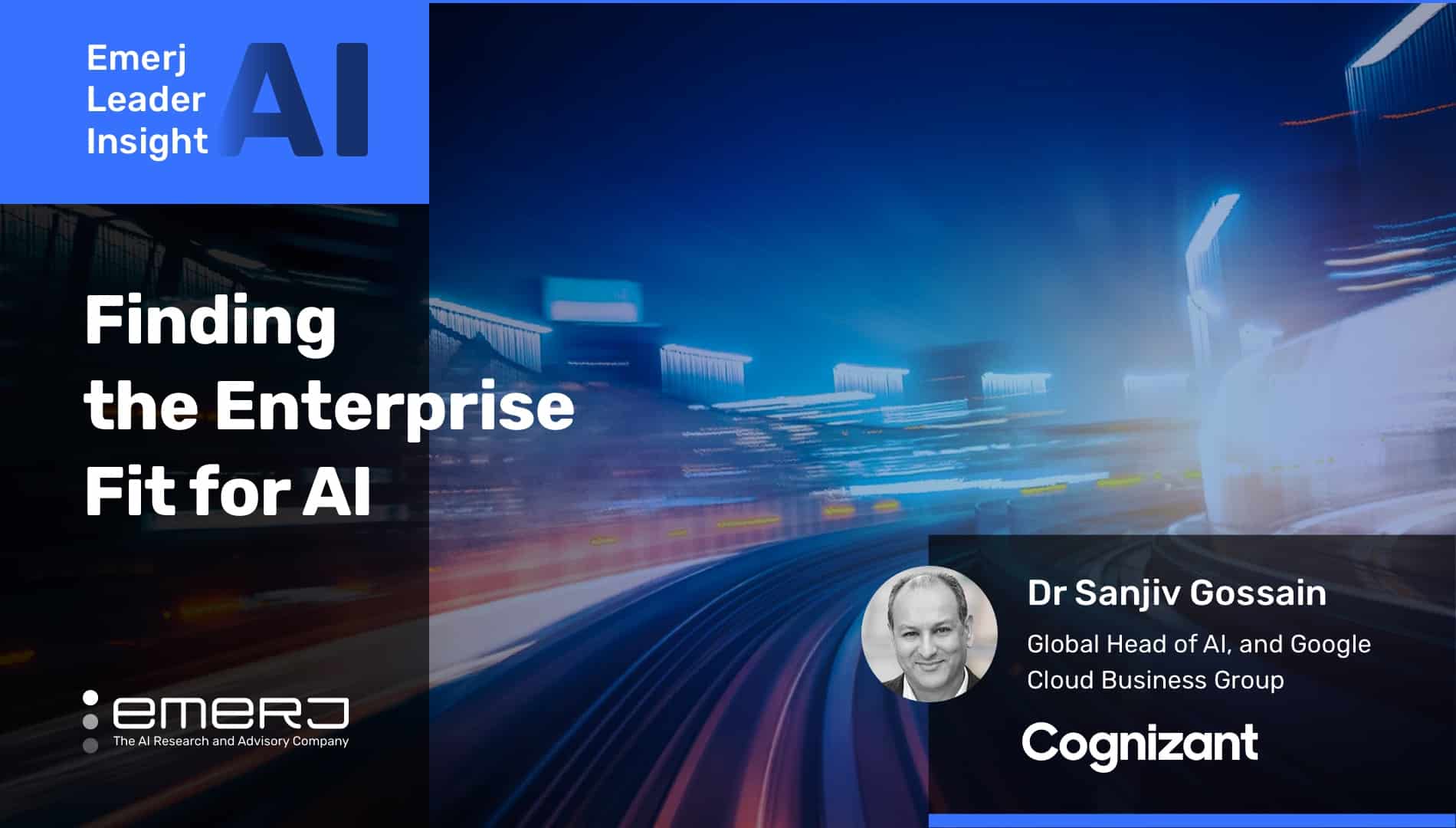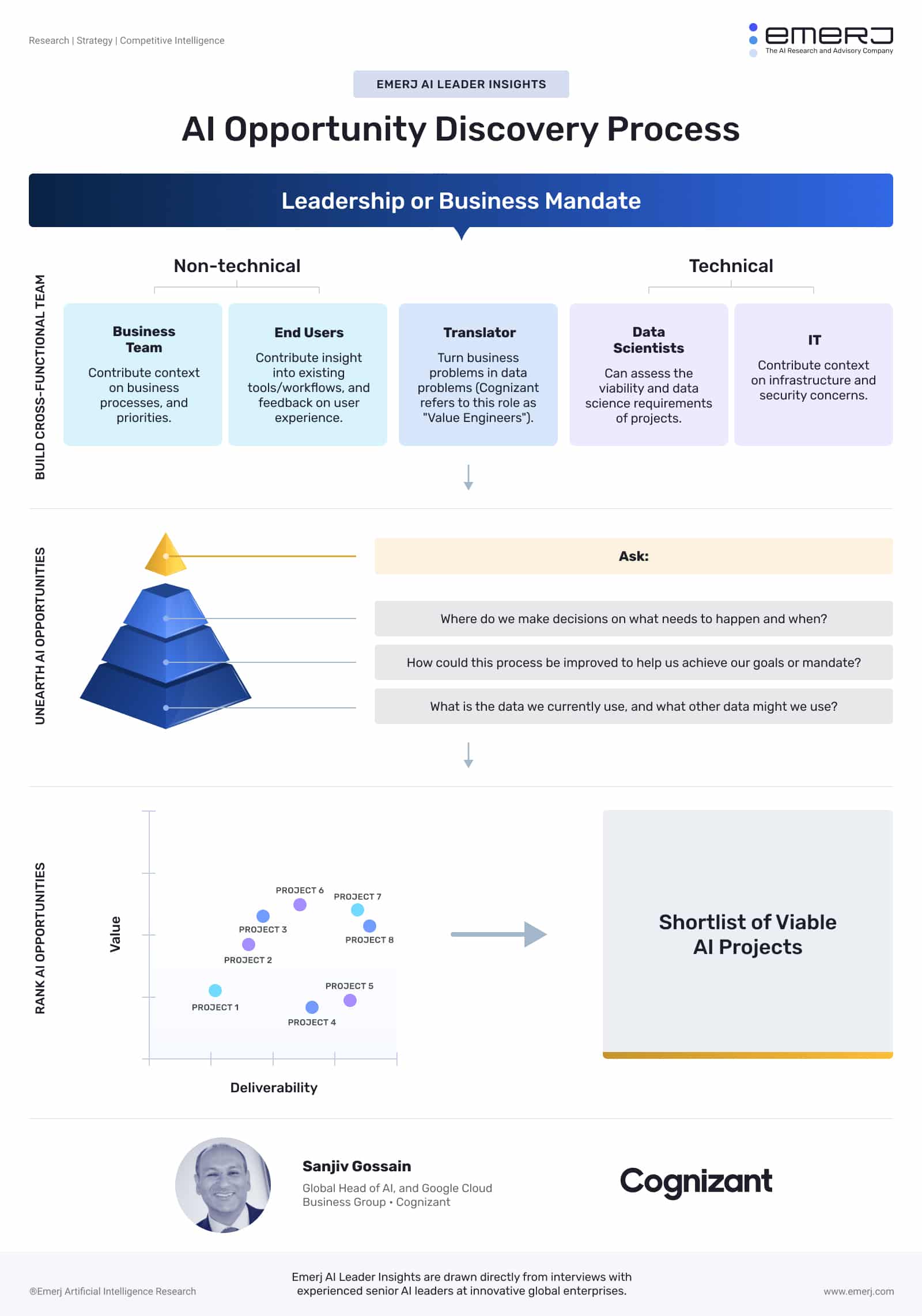
In the classic business book Good to Great, author Jim Collins talks about the different approaches for technology adoption between high-performing and average companies. Collins’ research indicated that high performers tend to adopt technology as an accelerant to an existing, working strategy – while underperformers tended to adopt technology in an attempt to jumpstart a change in direction or strategy that they haven’t yet undertaken.
Given the low level of executive AI fluency is in most enterprises today, leadership often treats AI either as a band-aid to fix near-term or novel problems, or as a kind of “infusion” of the new technology for its own sake – with projects selected arbitrarily.
What’s a better way to think about AI project selection?
We’ve decided to start a new series called Emerj AI Leader Insights, where we’ll speak with an AI leader at a renowned firm – and distill their best AI adoption or AI strategy advice into a useful graphic or resource that other leaders can put into practice immediately. While we’ve covered topics like AI project selection in great depth in previous Emerj Plus articles – we wanted to have a new article series to highlight approaches and advice directly from leaders in industry.
This week on The AI Consulting Podcast we spoke with Sanjiv Gossain, Global Head of AI and Google Cloud Business Group at Cognizant, one of the world’s most prominent technology services firms. We decided to drill down specifically on the process of finding the AI fit in the enterprise. In the article below you’ll find the full podcast interview, as well as the infographic framework and full written breakdown of Sanjiv’s advice.
Emerj AI Leader Insight – Finding the Enterprise Fit for AI

Interview – Sanjiv Gossain of Cognizant
Sanjiv’s core advice for finding the AI fit in an enterprise boils down into three phases:
Phase 1: Build a Cross-Functional Team
Finding and assessing AI opportunities requires expertise on the business processes (generally from non-technical team members) as well as expertise in data science, data infrastructure, IT infrastructure and even security. When these teams work together under a general mandate from leadership, they can use their respective strengths to not only identify potential areas of AI applications, but they can also assess the viability and priority of AI projects.
One of the unique challenges of AI opportunity discovery is translating business problems into data problems. For a given business outcome or workflow improvement, what data sources might be needed? What features would need to be included in that data? Sanjiv tells us that Cognizant has an entirely unique role – the “Value Engineer” – whose job it is to do this AI translation work and bridge the gap between the technical and non-technical worlds.
Phase 2: Unearth AI Opportunities
Once the proper AI opportunity discovery team is put in place with a clear business mandate, the team can begin creating a list of possible AI use-cases and pockets of value. Sanjiv lists a series of questions that can help serve as prompts and starting points – listed roughly in order:
- Where do we make decisions on what needs to happen and when?
- How could this process be improved to help us achieve our goals or mandate?
- What is the data we currently use in this business process, and what other data might we use?
There are many hypothetical starting points for AI project discovery – listen to related interview insights from other episodes on The AI in Business Podcast:
- Assess Your Data to Find AI ROI Opportunity – With Adam Bonnifield of Airbus
- A Framework for Long-Term and Near-Term AI ROI – With David Carmona of Microsoft
Phase 3: Rank AI Opportunities
Once potential projects have been collected, the cross-functional team can assess them realistically and determine which projects might be selected first. Sanjiv advocates that teams plot projects along the axes of value (the potential ROI of the project) and deliverability (the relative effort or resources required to achieve the desired value) in order to find sweet spot opportunities.
Like is Cognizant colleague Babak Hotjat, Sanjiv advocates that leaders focus on substantial initiatives first, rather than playing at the surface with smaller AI projects.
AI Best Practice Tools for Leaders
At Emerj Artificial Intelligence Research, we focus on distilling AI best practices into tools and frameworks that leaders and put in action immediately. AI strategists and consultants around the world use Emerj Plus to develop AI strategies and predict or convey the ROI of AI with confidence.
Unlock our full AI use-case and white paper library, as well as our ever-expanding set of best practice guides and infographics with Emerj Plus.








